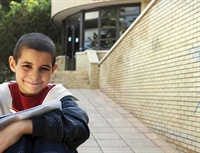Leadership training for youth is an investment in our present and future. Yet providing effective training can be challenging in terms of time and curriculum—especially in high-poverty communities, as we discovered in a pilot study of leadership training at an inner-city middle school.
An interdisciplinary team of professors collaborated with a principal and behavioral interventionist at an urban middle school to establish a leadership academy for seventh and eighth graders. Every other week during the academic year, students participated in leadership training in the following areas:
- Leadership. In two-hour training sessions, students met after school to focus on the following key areas: Tools for Academic Success, Team Building, Problem Solving, Conflict Resolution, Barriers to Success, Career Development, Community Involvement, and Servant Leadership.
- Team Building. An outdoor recreation leadership course conducted by professionally trained leadership facilitators focused on developing team-building and communication skills.
- Service Learning. Students served their school community by hosting Parent Teacher Organization meetings, preparing for teacher appreciation luncheons, and doing campus beautification projects.
- Academics. An education graduate student tutored participants in mathematics and science twice a week during school hours to improve their academic performance.
- Goals. Community leaders directed discussions that emphasized the importance of achieving educational and personal goals.
- College. Students had the opportunity to visit universities throughout the state.
- Community. University-sponsored cultural events were opportunities for students to increase awareness of community issues.
Participants’ parents attended a parent orientation about the goals of the leadership academy and chaperoned field trips.
Making It Work

Most of the students were exposed to places, people, and experiences that they would not have encountered otherwise.
Over a two-year period, we worked with approximately 85 students. Student and parent feedback about the leadership academy was very positive. Most of the students were exposed to places, people, and experiences that they would not have encountered otherwise. Parents appreciated the opportunity for their students to develop leadership skills and to learn more about college preparation.
Due to challenges regarding transportation for students after the leadership seminars, we implemented a three-day residential summer leadership camp on the university campus for the second school year. This program structure allowed for 100% participation, concentrated training time, and exposure to the college experience.
This program helped us identify several issues that affected the success of leadership training at this inner-city school: time, external factors, essential skills, leadership, and school climate. Each issue became a challenge to better serve students and enhance their perception of leadership.
Time. Planning a youth leadership program requires an extensive time commitment. Initially, educators must analyze the population and assess school climate, available resources, and program objectives based on student needs. Time spent gathering information from students during informal conversations and formal selection interviews was beneficial in designing a program to meet student needs.
In the beginning, we determined the program structure based on program components, frequency of sessions, and session length. To create the schedule, we factored in the school calendar, facilitators’ schedules, and availability of guest speakers. Also, we had to consider availability of transportation home from after-school sessions. The behavioral interventionist played a key role as a liaison in assisting with scheduling and transportation issues.
External Factors. Participants in the leadership academy faced many difficult issues in the home and school environment that created barriers to their academic success and affected how much they benefited from the leadership program. Some students showed progress in their academics and behavior at school until external factors such as violence, drugs, crime, child abuse and neglect, or poverty hindered their personal and social development.
Many of these external factors are beyond the students’ and educators’ control. Nevertheless, external factors create realistic obstacles for students and should be considered when developing leadership training programs for students.
Essential Skills. A program that defines such leadership skills as communication, teamwork, collaboration, and group consensus neglects the fact that some students don’t yet have the basic life skills to be successful. Program goals may be predicated on teaching students such basic skills as introducing themselves, participating in conversations, responding to both negative and positive criticism from adults and peers, and setting individual standards of behavior and achievement.
Leadership Concept. In some schools, students admire peers who disrespect the teachers, bully students, disrupt the classrooms, embarrass other students, disobey school rules, or do not achieve academically. This negative perception of leadership may have developed from a lack of positive leadership models in the home, school, and other environments.
Redefining leadership for students who often live in negative environments is a difficult task. Traditional processes of leadership cannot be built upon in a leadership program until essential skills are addressed, students are trained in coping techniques, and they exposed to other definitions of leadership.
The challenge is to transform the student’s perception of leadership from inappropriate behavior to responsible decision making. Leadership activities and guest speakers must be centered around identifying new characteristics of leadership and exposing students to leaders who exemplify those characteristics in a way that is meaningful and relevant to them.

Lack of textbooks, inconsistent teacher attendance, nonexistent parent involvement, and disruptive behavior in classes affect students’ ability to learn.
School Climate. Students sometimes are expected to excel in an environment that is not conducive to learning. Lack of textbooks, inconsistent teacher attendance, nonexistent parent involvement, and disruptive behavior in classes affect students’ ability to learn. It was essential to have cooperation from administrators, teachers, and parents. The principal supported the program by attending field trips, providing a school liaison, recognizing students in school assemblies, and granting special privileges to participants.
Planning for Success
Based on our pilot program, we offer the following recommendations to educators interested in developing and implementing a leadership academy program within the curriculum:
- Invest a considerable amount of time getting to know the students in the school environment and in the community. Only then can you truly understand who they are and what they need.
- Incorporate personal and social issues as authentic opportunities for students to learn more about decision making and responsibility. Tie leadership concepts to real-world situations with which they can identify.
- Include essential skills training to give students a foundation for success.
- Provide students with the opportunity to interact with positive leaders through guest speakers and field trips.
- Help students learn how to become agents of change within the school environment and the community.
Cookie cutter approaches to leadership training are not always successful. Practitioners, nonprofit organizers, and any professionals working with middle school students can help improve students’ leadership skills by ensuring their programs meet the needs of the students they are serving.
Previously published in Middle Ground magazine, February 2009